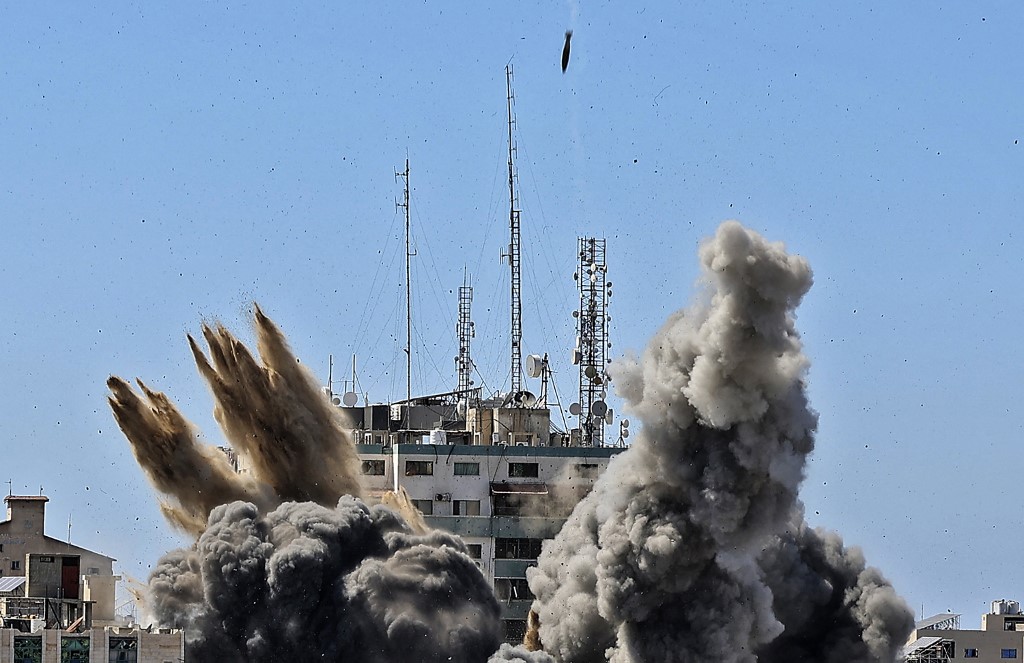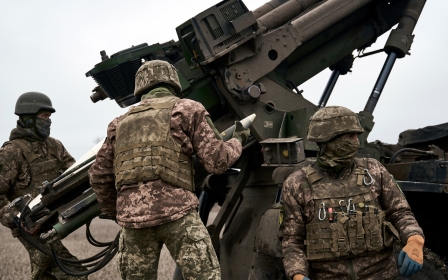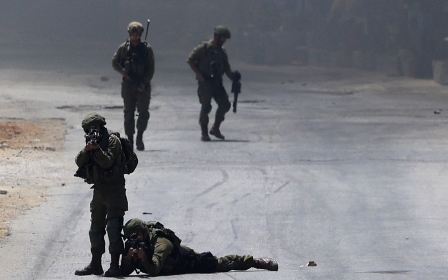American media love the arms trade, as long as the arms dealers are American

US media outlets have been apoplectic about Russia’s use of Iranian drones in Ukraine but routinely portray US weapons exports as a benign, if not benevolent, force.
In Forbes, for example, Paul Iddon denounces Iran as "an accomplice and enabler of wanton Russian aggression". Ellie Geranmayeh and Cinzia Bianco write in Foreign Policy that that America and Europe should focus "on ways they can interdict and counter Iranian weapons used in Ukraine as well as increase the tangible costs for Iran with its own public".
There is a dearth of cases of US media using comparable language to describe the effects of American-made weapons
In the same publication, John Hardie and Behnam Ben Taleblu write that Iran’s Shahed-136 drone has helped Russia’s "campaign of terror" in Ukraine and that such arms exports are part of Iran’s "offensive against the West.”
Iranian drone shipments to Russia are among the reasons a Washington Post editorial gives for asserting that Iran is "foment[ing] . . . trouble" internationally and engaging in "aggressiveness abroad" by "helping Russia destroy Ukraine".'
Not only is there a dearth of cases of US media using comparable language to describe the effects of American-made weapons, but glance at coverage from the last week or so, and you’ll find outright praise for US arms provisions.
New MEE newsletter: Jerusalem Dispatch
Sign up to get the latest insights and analysis on Israel-Palestine, alongside Turkey Unpacked and other MEE newsletters
'Real leadership'
On CNN, Peter Bergen asserts that US President Joe Biden and Secretary of State Anthony Blinken have shown "real leadership" on the Ukraine war by taking actions such as authorising "military aid to Ukraine, including highly accurate HIMARS missiles and soon M1 Abrams tanks".
Yet as Jeffrey Sachs points out, the Biden administration "poured cold water on the negotiations in March, when Ukrainians were contemplating a negotiated end to the war but instead walked away from the negotiating table". For Bergen, it seems "real leadership" is when a head of state uses their leverage to keep a war going and then provides the means for the blood to keep flowing.
In the same vein, Brett Stephens of The New York Times insists: "It's time to arm Ukraine with the arms it needs to win quickly - including F-16s - not just to survive indefinitely". The Bulletin of the Atomic Sciences, however, advocates the opposite. The group condemns the Russian aggression while suggesting that:
At a minimum, the United States must keep the door open to principled engagement with Moscow that reduces the dangerous increase in nuclear risk the war has fostered. One element of risk reduction could involve sustained, high-level US military-to-military contacts with Russia to reduce the likelihood of miscalculation. The US government, its Nato allies, and Ukraine have a multitude of channels for dialogue; they all should be explored. Finding a path to serious peace negotiations could go a long way toward reducing the risk of escalation.
Stephens is hardly the only one to flatter the US arms industry. A Wall Street Journal op-ed by Michael Makovsky and Blaise Misztal says that a "US arms depot in Israel has become a stockpile of democracy in recent months, as the Biden administration has transferred its artillery shells to Ukraine".
The depot in question, the War Reserve Stockpile Ammunition-Israel (WRSA-I), exists so that in case of war in the region, both Israel and the US will have easy access to weapons. Makovsky and Misztal repeat the same claptrap about democracy at the end of the piece, writing that: "The stockpile of US weapons in Israel should be used to give Ukraine any and everything it needs. But then America should quickly upgrade and refill it" for US-Israeli use in the Middle East "to make sure that the next time a conflict erupts, the WRSA-I can again serve as a much-needed stockpile of democracy".
'Stockpile of democracy'
Makovsky and Misztal's take on the Ukraine war is, at best, breathtakingly naïve. The conflict is a proxy war between Russia and Nato, chiefly the United States. America and its allies aren’t deluging Ukraine with weapons so that it can be a democracy but because Nato is in a geopolitical struggle with Russia, a war of position that gets in the way of Ukrainians governing their own affairs.
Saying that the US and Israel use weapons in the Middle East for "democracy" is absurd on its face. American weapons in the region prop up brutal pro-US tyrannies and are used for American invasions and occupations that kill and unleash death and destruction at scales that are hard to fathom, as what happened in Iraq. Israel, for its part, uses American armaments to attack the region’s peoples, often at a grave cost.
Makovsky and Misztal deal with such bloodshed by invoking, you guessed it, Iran. Israel, the authors say, used the WRSA-I twice, "during its 2006 conflict with Lebanon, and again in 2014 during its war with Gaza. The US benefited from this, too, in helping a critical ally defend itself against Iran-backed terror organisations".
The UN Human Rights Council offers a rather different view on how Israel used its largely US-supplied arsenal in the 2006 assault on Lebanon, finding that Israel undertook "a widespread and systematic campaign of direct and other attacks throughout its territory against its civilian population and civilian objects, as well as massive destruction of its public infrastructure, utilities, and other economic assets".
Israel killed over 1,100 Lebanese people, the vast majority of them civilians, with Lebanese children accounting for roughly one-third of the dead and injured - inconvenient facts for Makovsky and Misztal’s propaganda about "Iran-backed terror organisations".
And far from "defend[ing] itself" in the 2014 war, Israel was, as Amnesty International put it, employing American weapons "to violate human rights. The US government must accept that by repeatedly shipping and paying for such arms on this scale they are exacerbating and further enabling grave abuses to be committed against civilians during the conflict in Gaza".
Twenty-three days into the war, the "Iran-backed terror organisations" against which the Israeli military bravely struggled included "more than 1,400 Palestinians, mostly civilians", many of them children and humanitarian workers.
Massacring civilians
With rhetoric about American weapons exports being evidence of "real leadership", and how US arms function as a "stockpile of democracy", one could be forgiven for thinking that American weapons don’t kill and maim people at all.
Well, commentators of the Bergen-Makovsky-Misztal-Stephens school of thought might reply, what if these armaments are mainly being used against bad people and preventing worse harms than would occur had this weaponry not been used? Even just the last few years are rife with examples of American weapons massacring civilians.
With rhetoric about American weapons exports being evidence of 'real leadership' or supporting 'democracy', one might think that American weapons don’t kill and maim people at all
When Saudi Arabia and its allies bombed a funeral in Yemen in 2016, killing at least 100 people and wounding more than 500 - including hundreds of dead and injured civilians - the coalition did so with "a US-manufactured air-dropped GBU-12 Paveway II 500-pound laser-guided bomb". Scant corporate media coverage in the US characterised America as "an accomplice and enabler of wanton [Saudi] aggression" or as a participant in a "campaign of terror" in Yemen.
Likewise, in Israel’s May 2021 aggression against Gaza, the Israeli military killed 42 Palestinians, ten of them children, on the Strip’s al-Wehda Street. Human Rights Watch concluded that: "The al-Wahda Street strikes involved the use of 1,000-kilogram GBU-31 series air-dropped bombs mounted with a Joint Direct Attack Munition (JDAM) guidance kit. This kit is produced by Boeing and exported by the United States to Israel".
There is a distinct shortage of US media accounts of the slaughter saying, for instance, that America is engaging in "aggressiveness abroad" by "helping [Israel] destroy [Palestine]" or that states should focus "on ways they can interdict and counter [American] weapons used in [Palestine] as well as increase the tangible costs for [the US] with its own public".
I’m not suggesting that Iran, or anyone else, should help Russia’s war effort. What I am saying is that when American media cover official enemies' weapons exports, these outlets act as if they find the arms trade morally abhorrent. But when they cover US weapons exports, American media sound like they're doing PR for Boeing or Raytheon.
The views expressed in this article belong to the author and do not necessarily reflect the editorial policy of Middle East Eye.
Middle East Eye delivers independent and unrivalled coverage and analysis of the Middle East, North Africa and beyond. To learn more about republishing this content and the associated fees, please fill out this form. More about MEE can be found here.







